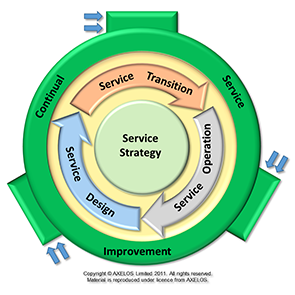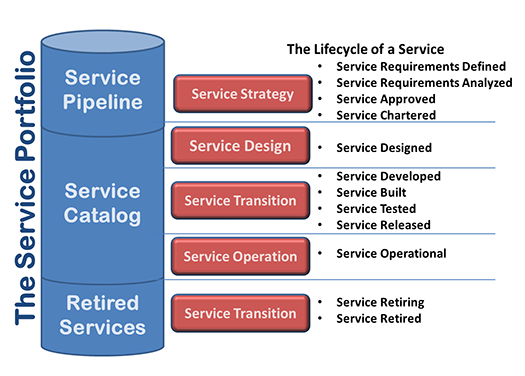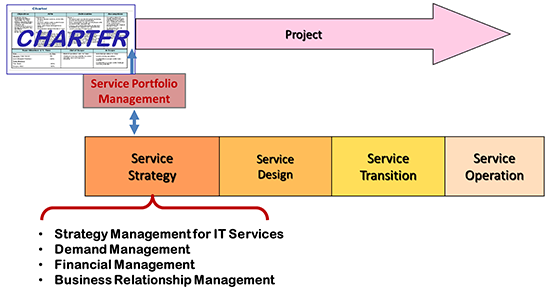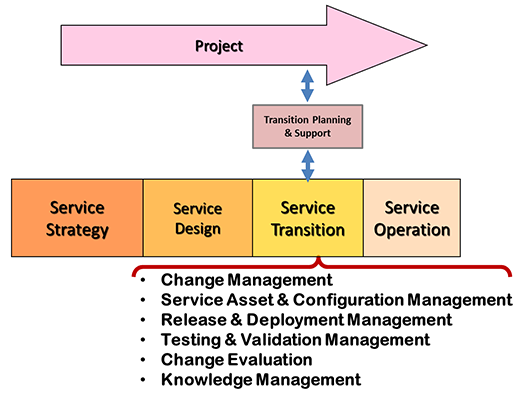Wow! Did you read the title of this article? OK, you most likely did. And perhaps that’s why you’re reading this now, because your immediate response might have been “What? Of course CSI is a service lifecycle stage. Look! There it is, right there in the Service Lifecycle diagram!”

Ah, but is it really? I have maintained for years that Continual Service Improvement isn’t a lifecycle stage but, rather, something you do during all stages of the service lifecycle.
The concept of the Service Lifecycle was introduced in 2007 within ITIL® Version 3 as in the Service Lifecycle diagram. ITIL® still consists of five core books: Service Strategy, Service Design, Service Transition, Service Operation and Continual Service Improvement. So, it stands to reason that each of these five core books corresponds to a stage within the service lifecycle diagram, right?
WRONG!
The service lifecycle is actually defined within and through something called “The Service Portfolio,” which is managed by a process, appropriately named the Service Portfolio Management Process, which, in turn, is defined with the ITIL® Service Strategy book. The Service Portfolio is made up of three parts: The Service Pipeline, the Service Catalog, and Retired Services.
It’s been said that the service lifecycle takes services from cradle to grave, but, in reality, it takes them from “the twinkle in the eye to the retirement home.” Services move through the three sections of the Service Portfolio during their actual lifecycle, as illustrated in the following diagram.

During Service Strategy the entire service lifecycle is managed, via the Service Portfolio Management Process. It is also during Service Strategy where the requirements for any possible new (or changed) service are defined and analyzed. If it is determined that there is sufficient value in pursuing the new or improved service, the Service Portfolio Management Process approves it and a project is chartered to create the new (or update an existing) service.
Once chartered, the service can move into the Service Catalog and then design work can commence where everything necessary to realize the service and its associated value is considered and captured within something called the Service Design Package (SDP).
Based upon this SDP, the service goes into and through the transition stage, where it is developed, built, and tested. The result of a successful transition is that the service becomes live, released into the production environment and the operation stage where its value is ultimately realized.
As time goes by, the service may reach a point where it is no longer able to deliver adequate value, in which case it is transitioned into a retired state from which, if ever needed, it could become operational once again.
So the question is where, exactly, does Continual Service Improvement fit? The answer is everywhere!

Consider these questions:
- Can you get better at Service Strategy? Of course you can!
- Can you get better at Service Design? You bet!
- How about getting better at Service Transition? Sure!
- And can you get better at Service Operation? Absolutely!
And, get this: You can actually get better at getting better! You can improve your ability to improve!
As a matter of fact, one of the stated objectives of CSI is to “Review, analyse, prioritize and make recommendations on improvement opportunities in each lifecycle stage: Service Strategy, Service Design, Service Transition, Service Operation and Continual Service Improvement itself,” according to the ITIL® Continual Service Improvement book.
Continual Service Improvement, then, is not a stage of the service lifecycle but is something that is built into all stages of the service lifecycle. And it starts in Strategy.
Part of the scope of CSI is the “continual alignment of the service portfolio with the current and future business needs” (ITIL® Continual Service Improvement). The Service Portfolio Management process uses CSI to ensure that the value of each service within the portfolio is aligned to the ever-changing needs of customers and the business. It receives input from other Strategy processes in order to understand strategic needs and establish priorities and to help determine requirements, demand, and financial impacts.
It’s the Service Portfolio process that creates the “Charter” to kick off projects that are responsible to produce new or changed services.

Improvement continues during Service Design. Each process defined within Service Design is coordinated by the process known as Design Coordination.
The Design Coordination process is the liaison, or linkage, between all of the activities taking place within the Service Design stage of the lifecycle and the project that was chartered to produce the new or changed service.
Design Coordination is also responsible for the entire Service Design stage of the lifecycle: The Design Coordination process has the explicitly stated objective to “monitor and improve the performance of the Service Design lifecycle stage” (ITIL® Service Design). This reinforces the point that CSI is not a stage of the service lifecycle, but is built into the service lifecycle!

Continual Service Improvement keeps working during Service Transition.
In a similar way that Service Design processes are coordinated by Design Coordination, Transition Planning and Support acts as the liaison between all of the activities taking places within the Service Transition stage of the lifecycle and the project that was chartered to produce the new or changed service.
Transition Planning and support is also responsible for the entire Service Transition stage of the lifecycle in that an explicitly stated objective of the process is to “Monitor and improve the performance of the Service Transition lifecycle stage” (ITIL® Service Transition). CSI is built into the service lifecycle!

It is best practice that every process defined within each stage of the service lifecycle should have an associated Process Owner. A big responsibility of each Process Owner is to review opportunities for process enhancements and for improving the efficiency and effectiveness of his or her process.
Further, every service should have associated with it a Service Owner, who, among other things is responsible for:
- Identifying opportunities for service improvements, discussing these with the customer and raising Requests for Changes, as appropriate.
- Identifying improvement opportunities for inclusion in the continual service improvement (CSI) register
- Working with the CSI manager to review and prioritize improvements in the CSI register
- Making improvements to the service.
“The service owner is responsible for continual improvement and the management of change affecting the service under their care.” (ITIL® Service Strategy, 2011 Edition)
So, as you can see, Continual Service improvement isn’t a stage of the service lifecycle. It is part of the very fabric which makes up the entire service lifecycle. As such, CSI is almost as strategic as strategy itself.
ITIL suggests that Service Strategy is there “…to improve the alignment between…capabilities and their business strategies” (ITIL® Service Strategy). Continual Service Improvement is “for ensuring that the service portfolio continues to be aligned to business needs” (ITIL® Continual Service Improvement). So without CSI, it wouldn’t take long for a Strategy to become ineffective, or worse, irrelevant.
It is cultural. It becomes integrated into your organization’s values, processes. It becomes an integral part of how you think and act. It is about doing things better:
- Doing: Taking positive action, today.
- Things: The services we deliver, the processes we execute, the technologies and tools we use.
- Better: Continually looking for new, improved, faster, and more efficient ways to maximize our value.
So, Continual Service Improvement is really a mind-set. A CSI mind-set recognizes that you may already be pretty darn good! As a matter of fact, you may even be considerably better than your competition. But CSI also recognizes that you can – and you have a responsibility to – get better. And your competition most certainly is not standing still!
Thank you to Jim Bolton and Buff Scott III for your guidance.
